
Original Link: https://www.anandtech.com/show/2176
The Zalman Twins: 9500 & 9700 Air Tunnels
by Wesley Fink on February 19, 2007 12:40 AM EST- Posted in
- Cases/Cooling/PSUs
Zalman is a name that instantly comes to mind with Computer Enthusiasts when cooling is mentioned. However, Zalman built its reputation with low-noise products and not with high performance. Silence and Zalman go hand-in-hand, but that is not normally the same as best performance. Zalman is a company that builds an exotic fanless power supply, a fanless GPU cooler, the Reserator 2 fanless water-cooled case, and huge copper fin CPU coolers with large, low-speed fans for cooling.
To be frank, Zalman most likely is the reason for the current fashion of large fans running at slow speeds, which has proven to provide superior cooling with much lower noise than smaller fans running at high speeds. A South Korea based company, Zalman has quickly grown in the past few years from a "good-idea" product to a huge product line based on the silent or low-noise cooling concept. With the growth have come additional offices, with US offices located in Garden Grove, California.
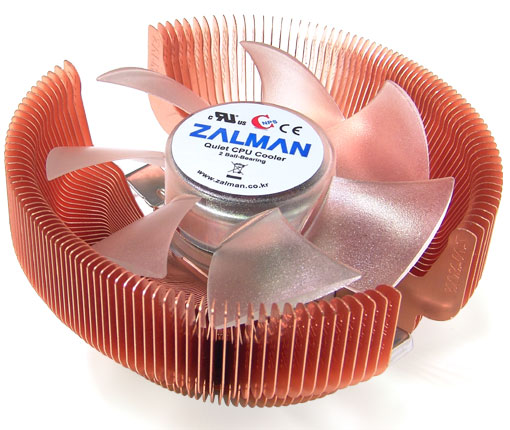
The CNPS9500 and CNPS9700 families are roughly based on the current thinking about heatpipe tower cooling - with a Zalman twist. From the very first Zalman coolers a few years ago, we have seen huge multi-finned circular coolers with a large, proprietary contained cooling fan. The CNPS7500 you see above is a good example of the typical Zalman CPU cooler.
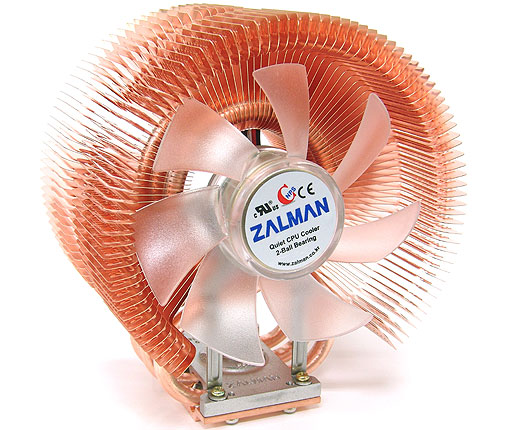
Last year Zalman introduced an update to this concept in the Zalman CNPS9500. The 9500 turned the large orb on its side, supported by looped heatpipes that claimed the efficiency of a six heatpipe design. Zalman had their version of the increasingly popular and effective heatpipe tower.

A few weeks ago at CES, Zalman introduced a larger version of the 9500 which they call the CNPS9700. The larger all-copper 9700 increased the embedded fan size from 92mm to 110mm. This provided a larger and higher capacity "air tunnel" for cooling.
With so much attention from Zalman on cooling, the obvious question is whether the Zalman 9500 and 9700 continue the Zalman tradition of ultra quiet cooling. Does Zalman still lead the pack in quiet designs, or have competitors caught up? There is also the important question of whether the Zalman is also a good choice for performance cooling. Large fans move a lot of air at low noise, so are the Zalman 9500 and 9700 CPU coolers a good choice for the overclocker?
Zalman 9500
The Zalman 9500 burst onto the scene with the introduction of the AM2 processor about 9 months ago. It is a cooling product recommended by NVIDIA for use with their chipset motherboards for AMD. As a result the 9500 series is available in two models, the CNPS9500 AM2 and the CNPS9500 LED. The heatsinks and fans are both the same, but the cosmetics and mounting kits are different.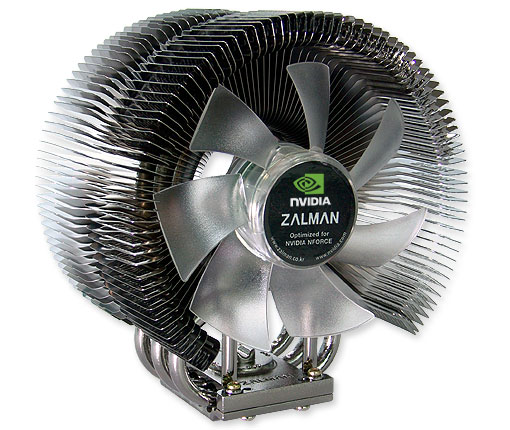
The AM2 version has a coating which makes it look like it is dark nickel plated and the fan has green LEDs to match an AMD color scheme. The AM2 only comes with AM2 mounting hardware and it includes the Fan Mate 2 fan controller. The LED version is the regular copper color with blue LEDs and the mounting hardware for Intel Socket 775, Intel 478, AMD 754, AMD 939, and AMD 940. It does not support AM2, but it also includes the Fan Mate 2.

The 9500 (and larger 9700) feature the Zalman Air Tunnel design, which Zalman claims is optimized for air cooling efficiency. The 9500 fan is a 92mm custom embedded fan, and it is not user interchangeable with other 92mm fans.

Since we have a good collection of Zalman coolers in the lab, it is worth mentioning that the 9500 and 9700 hardware is interchangeable. The base is the same size and socket adapters can be freely used back and forth.
Installation is both easy and very well documented. The instructions are reasonably clear, but most Zalman coolers also include installation videos on their web-site. The installation video for the 9500 LED is available here and it includes tabs for installation on Socket 775, Socket 478, and Socket 754/939/940.
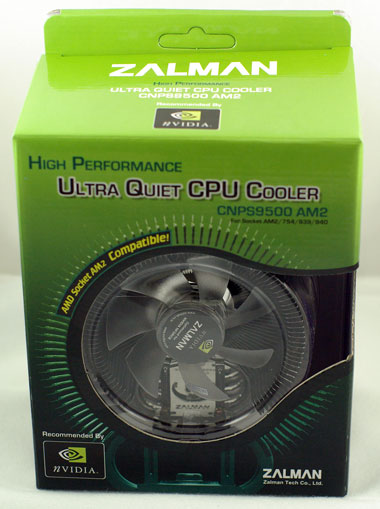
Our test version of the 9500 was for AM2, but the interchangeable installation parts from the 9700 made it very easy to mount the cooler on a Core 2 Duo in Socket 775.

If you plan to mount on a Core 2 Duo then you should buy the CNPS9500 LED, which includes the Socket 775 adapter for mounting. The adapter works as it should, but it is not a particularly precise piece of plastic. We had to push and prod the back plate to get the embedded nuts on the back plate to align with the holes on the 680i motherboard. In fairness that was the only thing difficult about mounting the Zalman 9500; everything else was very straightforward. The fan uses a 3-pin connector, which is basically not adjustable, but Zalman includes the excellent Fan Mate 2 adapter which provides variable fan speed to any standard fan.
Fan Mate 2
Like most of the top Zalman coolers, the 9500 series comes packaged with the excellent Fan Mate 2 fan controller. This useful little gadget allows speed control of any fan that can attach to a 3-pin fan header, by adjusting voltage on the 12V line. In future reviews we will use the Fan Mate to more conveniently measure noise at both low speed and high speed fan settings.
| Fan Mate 2 Specifications | |
| Dimensions | 70(L) x 26(W) x 26(H)mm |
| Weight | 20g |
| Output Voltage | 5V ~ 11V +/- 2% |
| Allowable Power | 6W or lower |
| Connector | 3-Pin |
Specifications
Our test system is Intel Socket 775, but the Zalman CNPS9500 LED will mount on a wide range of systems with various CPU sockets. All the needed hardware is included to fit the variety of supported sockets. The only current socket not supported is AM2. If you are planning to mount on an AM2 motherboard you will need the CNPS9500 AM2.
| Zalman CNPS9500 LED Specifications | |
| Heatsink | |
| Dimensions | 85(L) X 112(W) X 125(H)mm |
| Weight | 530g (including fan) |
| Material | Pure Copper |
| Dissipation Area | 3,698cm2 |
| Thermal Resistance - Silent Mode | 0.16 C/W |
| Thermal Resistance - Low-noise Mode | 0.12 C/W |
| Fan | |
| Fan Size | 92 mm |
| Bearing Type | 2-Ball Bearing |
| Speed - Silent Mode | 1,350rpm +/- 10% |
| Speed - Low-noise Mode | 2,600rpmM +/- 10% |
| Noise Level - Silent Mode | 18.0dB +/- 10% |
| Noise Level - Low-noise Mode | 27.5dB +/- 10% |
The 9500 is tall and wide, but it was designed to clear components on most motherboards. We had no trouble mounting the 9500 on several high-end boards we had available in the lab. At 530g, the 9500 is a lot lighter than the two-pound heatpipe towers we have tested. It is a bit heavier than recommended by AMD and Intel, but the added reinforcement from the mounting method should make the 9500 a relatively safe install on most motherboards.
Zalman 9700
The Zalman CNPS9700 is basically an oversized 9500, with a larger 110mm fan and a greater surface area of copper fins for cooling.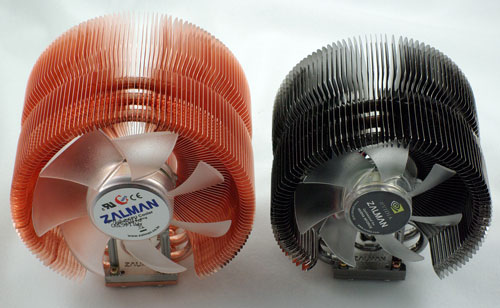
The size difference is pretty clear in this picture of the 9500 and 9700 side by side. The increase in size and copper also raises the cost. Where the 9500 series sells for around $60, the 9700 retails for about $75.
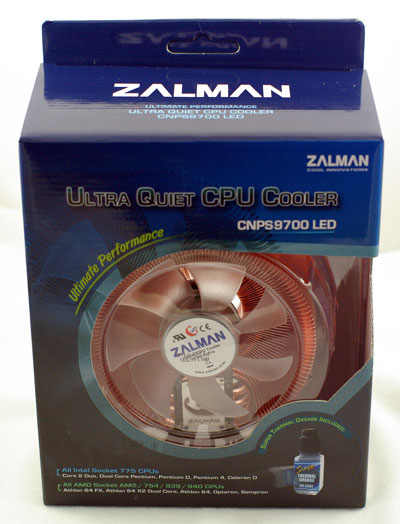
Packaging for the 9700 is about the same as the 9500. Zalman uses blue for the universal mount and Intel mount coolers, and green to designate AMD coolers. We would like to extend a thank you to Frozen CPU for providing the Zalman CNPS9700 for review.
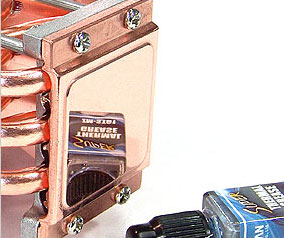
Few can complain about the polish of the copper mounting surface of the 9700. The 9500 was very similar, with a flat high polish pad that mates to the CPU. Mounting of the 9700 is exactly like the 9500. The same adapters and plates will work on either CPU cooler.
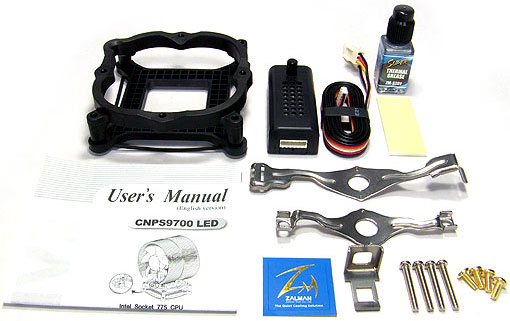
The 9700 includes all the same parts as the 9500 LED plus an AM2 adapter. It also includes the Zalman Fan Mate 2 fan controller. The 9700 can mount Socket 775, AM2, 754, 939, and 940. However, it drops support for Socket 478, which is now three generations back on the Intel tree. Also added is a bottle of Zalman Super Thermal Grease.
Zalman Super Thermal Grease
Included in the CSN9700 kit is a bottle of Zalman Super Thermal Grease with a brush in the cap to make application easier.
| Zalman Super Thermal Grease Specifications | |
| Type | Non-curing compound |
| Capacity | 3.5g |
| Specific Gravity | 2.42 |
| Temperature Stability | -40C-150C (-40F-302F) |
Specifications
Our test system is Intel Socket 775, but the Zalman CNPS9700 LED will mount on all current CPU sockets. All the needed hardware is included to fit the variety of supported sockets.
| Zalman CNPS9700 LED Specifications | |
| Heatsink | |
| Dimensions | 90(L) X 124(W) X 142(H) mm |
| Weight | Heatsink: 690g, Total (including fan): 764g |
| Base Material | Pure Copper and Aluminum |
| Dissipation Area | 5,490 cm2 |
| Fan | |
| Fan Size/Weight | 110 mm, 74g |
| Bearing Type | 2 Ball-Bearing |
| Speed - Silent Mode | 1,250RPM +/- 10% |
| Speed - Normal Mode | 2,800RPM +/- 10% |
| Noise Level - Silent Mode | 19.5dB +/- 10% |
| Noise Level - Normal Mode | 35dB +/- 10% |
The main difference between the Zalman 9700 and the 9500 is size and weight. The 9700 is 142mm tall compared to the 9500 height of 125mm. This 17mm height difference will matter to some with smaller cases, but neither of these two Zalman coolers is truly small. They are generally not suitable for small, flat Media PC cases or modular cases designed for rack mounting.
The 9700 also weighs 764g, compared to the 530g of the 9500. While the motherboard mounting method may handle the 530g weight just fine, you should be careful with the heavier 9700. At almost two pounds this is a heavy heatsink and the plastic mounting plates allow flex - they are not rigid like some of the metal plates used on competing large CPU coolers. It is probably not a good idea to use the 9700 on a PC that will be moved frequently, such as a LAN Party PC. Carrying around a mounted heavy cooler like the Zalman 9700 could be asking for trouble.
CPU Cooling Test Configuration
The standard test bed for cooling tests uses an EVGA NVIDIA 680i SLI motherboard. This is primarily based on the consistent test results on this board and the excellent NVIDIA Monitor temperature measurement utility, which is part of the nTune program.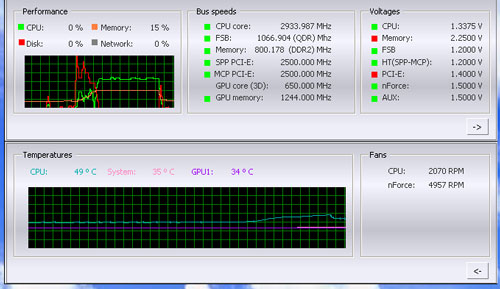
NVIDIA Monitor has a drop-down pane for temperature measurement which reports CPU, System, and GPU results. Reviews at this point will concentrate primarily on CPU temperature. In addition to the real-time temperature measurement, NVIDIA Monitor also has a logging feature which can record temperature to a file in standard increments (we selected every 4 seconds). This allows recording of temperatures during testing and play back, for example, of stress test results that can then be examined when the stress tests are completed. There is also the handy reference of speeds and voltages in the top pane to confirm the test setup.
Other components in the cooling test bed are generally the same as those used in our motherboard and memory test bed:
| Cooling Performance Test Configuration | |
| Processor | Intel Core 2 Duo X6800 (x2, 2.93GHz, 4MB Unified Cache) |
| RAM | 2x1GB Corsair Dominator PC2-8888 (DDR2-1111) |
| Hard Drive(s) | Hitachi 250GB SATA2 enabled (16MB Buffer) |
| Video Card: | 1 x EVGA 7900GTX - All Standard Tests |
| Platform Drivers: | NVIDIA 9.53 |
| NVIDIA nTune: | 5.05.22.00 (1/16/2007) |
| Video Drivers: | NVIDIA 93.71 |
| CPU Cooling: | Zalman CNPS9700 Zalman CNPS9500 Cooler Master Hyper 6+ Vigor Monsoon II Lite Thermalright MST-9775 Scythe Katana Tuniq Tower 120 Intel Stock HSF for X6800 |
| Power Supply: | OCZ PowerStream 520W |
| Motherboards: | EVGA nForce 680i SLI (NVIDIA 680i) |
| Operating System(s): | Windows XP Professional SP2 |
| BIOS | Award P24 (1/12/2007) |
All cooling tests are run with the components mounted in a standard mid-tower case. The idle and stress temperature tests are run with the case closed and standing as it would in most home setups. We do not use auxiliary fans in the test cooling case, except for the north bridge fan attached to the 680i for overclocking.
We first tested the stock Intel cooler at standard X6800 speed, measuring the CPU temperature at idle and while the CPU was being stressed. We stressed the CPU by running continuous loops of the Far Cry River demo. The same tests were repeated at the highest stable overclock we could achieve with the stock cooler. Stable in this case meant the ability to handle our Far Cry looping for at least 30 minutes.
The same tests were then run on the cooler under test at stock, highest stock cooler OC speed (3.73GHz), and the highest OC that could be achieved in the same setup with the cooler being tested. This allows measurement of the cooling efficiency of the test unit compared to stock and the improvement in overclocking capabilities, if any, from using the test cooler.
Noise Levels
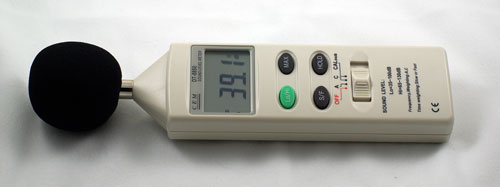
In addition to cooling efficiency and overclocking abilities, users shopping for CPU cooling solutions may also be interested in the noise levels of the cooling devices they are considering. Noise levels are measured with the case open on its side and are measured using a C.E.M. DT-8850 Sound Level meter. This meter allows accurate sound level measurements from 35bdB to 130dB with a resolution of 0.1dB and an accuracy of 1.5dB. This is sufficient for our needs in these tests, as measurement starts at the level of a relatively quiet room. Our own test room, with all computers and fans turned off, has a room noise level of 36.4dB.
Our procedures for measuring cooling system noise are described on page seven along with noise results comparing the stock Intel cooler and recently tested CPU coolers to the Zalman CNPS9500 and CNPS9700 coolers.
Cooling Results
The Zalman 9500 and 9700 are both excellent performers in CPU cooling at stock speeds. However, as overclocks were raised, neither cooler was particularly outstanding in the ability to cool the CPU under stress conditions. To be as fair as possible all overclocking tests were run with the 9500 and 9700 fans at the highest speeds they could be pushed to with the Fan Mate 2 controller. These fan speeds also generate a great deal more noise than the low speed settings on either cooler.
Where the very good Intel stock cooler keeps the X6800 at 41C at idle, the 9500 can manage an excellent 30C, with the 9700 doing even better at 28C. This is not quite as cool as the Tuniq Tower 120 at stock idle, but it is among the best performance we have seen at stock idle speeds. As processor speed increases, however, the Zalman starts dropping rapidly in efficiency. The higher the speed goes, even at idle, the greater the cooling performance delta between the 9500/9700 and the leading Tuniq Tower 120
At 3.73GHz the retail HSF is running at 56C, compared to 42/38C with the Zalman 9500/9700. The performance at idle with both Zalman cooler is quite good at stock speeds, but performance drops fast with increased CPU overclocking. Both Zalman coolers reach rather average overclocks, considering they are very expensive coolers. The 9500 tops out at 3.81 GHz and the 9700 tops out at 3.83GHz. Many of the top coolers we have tested have done better.
It is easy to measure the effectiveness of a cooling solution at idle - when the computer is doing nothing except running the temperature measurement program. It is more difficult, however, to effectively simulate a computer being stressed by all of the conditions it might be exposed to in different operating environments. For most home users CPU power is most taxed with contemporary gaming. Therefore our stress test simulates running a demanding contemporary game.
The Far Cry River demo is looped for 30 minutes and the CPU temperature is captured at 4 second intervals with the NVIDIA monitor "logging" option. The highest temperature during the stress test is then reported. Cooling efficiency of the Zalman 9500 and 9700 under stress conditions was compared to the retail HSF and other recently tested CPU coolers. Once again the well-regarded Tuniq Tower 120 was the top air cooling solution, with the TEC/air hybrid Monsoon II Lite as the top performer. Both Zalman coolers were very average in performance among the coolers we have tested and well behind the Tuniq and Cooler Master at the top of the air cooling chart.

The Tuniq keeps the CPU at 34C under stress at stock speeds, where the Zalman 9500 manages 39C and the 9700 does better at 36C. However, the same pattern emerges under stress testing that we first saw under idle conditions: as the overclocked CPU speed increases the cooling effectiveness of both Zalman coolers drops rapidly. By 3.83 GHz, which is the highest overclock the 9700 could reach with stability, the Tuniq is at 50C compared to the 5700 at 59C. The 9500 at its highest overclock of 3.81 GHz is at 59C. Both Zalman coolers appear to be optimized for excellent performance at or near stock speeds. While the Zalman coolers are among the top performers in cooling at stock idle and load, as speed increases their effectiveness drops rapidly.
As stated many times, the overclocking abilities of the CPU will vary at the top, depending on the CPU. This particular CPU does higher FSB speeds than any X6800 we have tested, but the 3.9GHz top speed with the Tuniq is pretty average among the X6800 processors we have tested with Tuniq cooling. A few of the other processors tested with the best air coolers reach just over 4 GHz, but the range has been 3.8 to 4.0GHz. Stock cooling generally tops out 200 to 400 MHz lower, depending on the CPU, on the processors tested in our lab. The 3.83 GHz with the Zalman 9700 and 3.81 GHz with the Zalman 9500 - both achieved with the cooler fans at their highest noisie levels - are average at best. We would expect premium-priced CPU coolers to perform better.
Overclocking
As cooling solutions do a better job of keeping the CPU at a lower temperature, then it is reasonable to expect the overclocking capabilities of the CPU will increase. In each test of a cooler we measure the highest stable overclock of a standard X6800 processor under the following conditions:CPU Multiplier: 14x (Stock 11x)
CPU voltage: 1.5875V
FSB Voltage: 1.30V
Memory Voltage: 2.20V
nForce SPP Voltage: 1.5V
nForce MCP Voltage: 1.7V
HT nForce SPP <-> MCP: Auto
Memory is set to Auto timings on the 680i and memory speed is linked to the FSB for the overclocking tests. This removes memory as any kind of impediment to the maximum stable overclock. Linked settings on the 680i are a 1066FSB to a DDR2 memory speed of DDR2-800. As FSB is raised the linked memory speed increases in proportion. The same processor is used in all cooling tests to ensure comparable results.

The Zalman 9500 reached just 3.812 GHz, which is middle of the pack and competitive with the much cheaper Thermalright MST-6775 and the Scythe Katana. The 9700 did a little better at 3.83 GHz. If you are just looking for bragging rights, then the 9700 booted fine at 3.90GHz, but unfortunately the system crashed whenever we tried to run any demanding tasks like gaming at any speeds above 3.83 GHz.
The overclocking performance of both Zalman coolers was disappointing. At $60 to $75 these are the two highest priced air coolers we have tested. You expect great performance if you pay more, but neither Zalman could deliver that kind of overclocking performance. Both the 9500 and 9700 were average in overclocking at best among the coolers we have tested. We can get average overclocking performance form coolers that cost just $25. Neither Zalman could justify their high prices based on overclocking performance, even though we tested both in overclocking at the highest fan speeds they could achieve, which also made them quite noisy.
The Tuniq Tower 120 is still the fastest air CPU cooler we have tested so far, with the TEC/air hybrid Monsoon II at the top of all overclocking charts with this CPU at 3.96 GHz. The Zalman 9500 and 9700 did not outperform the Tuniq, or even the Cooler Master Hyper 6+. Overclocking was in the ball park with the Thermalright and Scythe which are much lower cost and much lighter CPU coolers aimed at the heatpipe tower mainstream.
Noise
For many enthusiasts upgrading cooling the goal is maximum stable overclock, and they will live with the inconvenience of a louder system. For other users silence is the most important factor, and these users will forgo maximum overclocking if this increase system noise levels. In general the Zalman 9500 and 9700 can be considered very quiet, but performance of either cooler is not standout against the competition - at least where noise is concerned.To test idle and load noise levels, the Zalman fan controller was used to dial in the lowest and highest fan speeds the fan could achieve. Lowest speed results are reported as idle and high speed results are reported as stress noise. These are procedures that we plan to use, if possible, in future CPU cooler reviews. Both sets of results will be reported if there is a significant difference in low-sped and high-speed noise.
There are virtually no power supplies that do not have a fan. While Zalman and a few others do make a few expensive fanless power supplies, we have not seen a fanless unit larger than 500W, or one that would be used for seriously overclocking a system. With that in mind the noise level of the system with all fans turned off except the power supply was measured. The power supply used for the cooling test bed was the OCZ PowerStream 520, which is one of the quieter of the high performance power supplies. The noise level of the power supply was 38.3dB from 24" (61cm) and 47dB from 6" (152mm). The measured noise level of the test room is 36.4dB, which would be considered a relatively quiet room with a noise floor slightly below the OCZ PowerStream 520 PSU.


Measured noise levels in this chart should be considered worst case. Measurements were taken with an open side of a mid tower case 6" from the open HSF and 24" from the open HSF. Real world would be a completely closed case with a further reduction in noise.
Zalman, silence and low-noise all go hand-in-hand in the mind of most computer users, so Zalman is expected to be the standard against which others are measured. Put another way, noise is an area where Zalman is expected to top the charts. The Zalman 9500 and 9700 both exhibited noise levels below the system floor at idle speeds measured 6" and 24" from the cooler. This is typical performance with most of the heatpipe towers we have tested in recent weeks.
However, when pushed to the highest speeds available under stress conditions, the noise levels of the 9500 and 9700 were average at best. Neither Zalman was particularly quiet at high speed, and the 9700 was one of the noisiest coolers we have tested in the lab at 2800 RPM - 3db is twice the sound energy of the Tuniq Tower 120 at high speed and almost as loud as the Monsoon II Lite which is plagued by buzzing and clicks from fan switching. On low speed the 9500 and 9700 are very quiet, as are most heatpipe towers, but higher fan speeds yield much higher noise.
The measurements we made are also what you will get with either Zalman, since the fans are custom and embedded in the Zalman design. Zalman did not design the fans to be replaced with other 92mm (common size) or 110mm (Uncommon size fans). All-in-all the Zalman 9500 and 9700 were competitive with other tested coolers in noise levels, but they were not stand-out in any way. This is a reflection of how far the competition has come in addressing noise concerns in the PC environment.
Conclusion
Zalman pioneered many of the concepts we now take for granted in controlling noise in a computer. The use of large, low-speed fans to move lots of air with low noise was an early innovation of Zalman, and it is a technique now used in almost all the top heatpipe tower coolers. As demands for more cooling have increased the size of fans on even bargain CPU coolers has increased. Even manufacturer retail HSF fans are now often 80mm. The days of small, whining CPU cooler fans have thankfully mostly disappeared, although we still too often see these small, noisy fans on chipsets these days.The Zalman 9700 is a slightly better cooler than the 9500, but the performance differences are very small - the 9500 tops out in OC at 3.81 GHz where the 9700 reaches 3.83 GHz. Also the 9500 is a bit quieter across the board than the 9700 so you have to question whether the marginal 20 MHz improvement in OC is worth the extra noise from the 9700. Neither result, however, is even close to tops among our tested coolers. Both are pretty average among the coolers tested thus far.
The point of this is that while the Zalman 9500 and 9700 do exactly what they claim, the rest of the world has caught up, and in some cases passed Zalman. Neither Zalman cooler stands out in any way. They are quiet, but they are not quieter than other heatpipe towers we have tested. At high speed, which is needed for effective overclocking, they are often even noisier than the competition. The Thermal Grease, air tunnel, and other current Zalman innovations do not pay off in stellar overclocking, either, compared to the best current CPU coolers. The performance of both coolers is middling compared to what we have seen from competing coolers.
This is not a bad thing among a very high performing group of coolers. However the prices of these two Zalman coolers are anything but average. At $60 and $75 the 9500/9700 are more expensive than the $50 for the Tuniq Tower 120, which is both quieter than either Zalman, and the Tuniq outperforms both in overclocking. The performance of both Zalman coolers is very close to the Thermalright MST-6775 or the Scythe Katana, which are both decent small, light-weight heatpipe towers. The problem here is that both the Thermalright and the Scythe cost about $25 to $30 which is less than half the price of either the Zalman 9500 or the 9700. This is before you consider weight, since the Scythe weighs just 300g and the Thermalright also meets the manufacturer recommendations for weight. This makes both the MST-6775 and Katana much lighter and cheaper than the Zalman 9500 and 9700.
Zalman products have always been easy to admire, and our tests have not changed this perception. However, it is difficult to recommend either the Zalman 9500 or 9700 as a good value among CPU coolers. The top performing air cooler, the Tuniq Tower 120, costs less, overclocks better, and is quieter than either Zalman in a real world system. The Cooler Master Hyper 6+ also overclocks better and controls noise well at about half the price, while the Thermalright and Scythe perform about the same at less than half the price and half the weight.
If cost is not a concern then both Zalman coolers do what they claim and will perform well in your system. The highly advertised innovations like "air tunnel" and thermal grease may also work fine, but they didn't raise the performance or noise of the Zalman coolers above average in our tests. The Fan Mate is also useful, but certainly not worth an extra $20+ in total cost. There is also the Zalman advantage of a simple, well-engineered and well-explained installation. The Zalman coolers are very easy to install on almost any system, which is an important consideration in anyone's list.
If you are looking for value - the best performance and noise control for your dollar - then there are much better choices in the market than the Zalman 9500 and 9700. The top Tuniq Tower 120 and Cooler Master Hyper 6+ perform better, are just as silent, and cost less. The Thermalright MST-6775 and Scythe Katana perform about the same, but are much lighter and less than half the price of either Zalman. It gets even worse looking at the high end of coolers tested so far. The innovative TEC/air $89 Vigor Monsoon II Lite is only $14 more than the 9700, and it performs significantly better. Zalman may have started the quiet, high-performance cooling rage, but the 9500 and 9700 are not leaders by any measurement.







